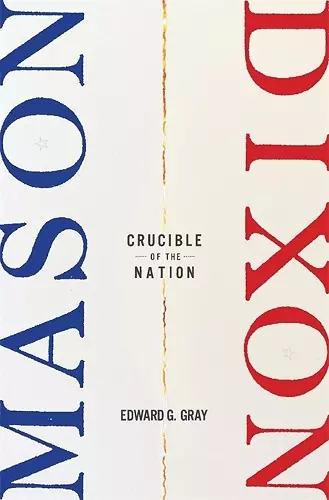Mason-Dixon
Crucible of the Nation
Format:Hardback
Publisher:Harvard University Press
Published:24th Nov '23
Should be back in stock very soon

“A magisterial yet highly nuanced account that ventures back and forth across Mason and Dixon’s fabled demarcation line as audaciously as 18th-century raiding parties once did.”—Harold Holzer, Wall Street Journal
The first comprehensive history of the Mason-Dixon Line—a dramatic story of imperial rivalry and settler-colonial violence, the bonds of slavery and the fight for freedom.
The United States is the product of border dynamics—not just at international frontiers but at the boundary that runs through its first heartland. The story of the Mason-Dixon Line is the story of America’s colonial beginnings, nation building, and conflict over slavery.
Acclaimed historian Edward Gray offers the first comprehensive narrative of the America’s defining border. Formalized in 1767, the Mason-Dixon Line resolved a generations-old dispute that began with the establishment of Pennsylvania in 1681. Rivalry with the Calverts of Maryland—complicated by struggles with Dutch settlers in Delaware, breakneck agricultural development, and the resistance of Lenape and Susquehannock natives—had led to contentious jurisdictional ambiguity, full-scale battles among the colonists, and ethnic slaughter. In 1780, Pennsylvania’s Act for the Gradual Abolition of Slavery inaugurated the next phase in the Line’s history. Proslavery and antislavery sentiments had long coexisted in the Maryland–Pennsylvania borderlands, but now African Americans—enslaved and free—faced a boundary between distinct legal regimes. With the passage of the Fugitive Slave Act in 1850, the Mason-Dixon Line became a federal instrument to arrest the northward flow of freedom-seeking Blacks. Only with the end of the Civil War did the Line’s significance fade, though it continued to haunt African Americans as Jim Crow took hold.
Mason-Dixon tells the gripping story of colonial grandees, Native American diplomats, Quaker abolitionists, fugitives from slavery, capitalist railroad and canal builders, US presidents, Supreme Court justices, and Underground Railroad conductors—all contending with the relentless violence and political discord of a borderland that was a transformative force in American history.
A magisterial yet highly nuanced account that ventures back and forth across Mason and Dixon’s fabled demarcation line as audaciously as 18th-century raiding parties once did. -- Harold Holzer * Wall Street Journal *
Deeply researched and highly readable. -- Eric Foner * Times Literary Supplement *
Fascinating…does justice to the full sweep and complexity of American history by expertly tracing a century of change across one especially revealing patch of ground. -- James H. Read * American Political Thought *
A fitting testament to a career marked by boundary-crossing curiosity and stalwart service to the historical profession…[a] splendid new history. -- Richard Bell * Register of the Kentucky Historical Society *
A rich history of regional distinctions, especially as they shaped the antebellum Republic. * Kirkus Reviews *
Erudite, gripping, and highly significant. Gray puts his talents as a historian of the American Revolution and the early republic to excellent use, persuasively arguing that the Mason-Dixon Line is worth seeing as a geopolitical border—a place where the layered sovereignties of colonies, empires, states, Native powers, and the US government often clashed. -- Kathleen DuVal, author of Independence Lost: Lives on the Edge of the American Revolution
A splendid book. The Mason-Dixon Line has always been much more than a boundary, and Gray gives us a richly researched, elegantly written history, exploring all of the twists and turns of a cartographic projection that was never quite as straight or simple as the surveyors hoped it would be. -- Edward L. Widmer, author of Lincoln on the Verge: Thirteen Days to Washington
An ambitious, engrossing book by one of our most prolific scholars of early America. This inspired history of the Mason-Dixon Line reveals that America’s most notorious borderland was also deeply representative of the broader national experience. Long before the region became synonymous with the frontier between slavery and freedom, its history was forged in imperial intrigue, Native dispossession, and rural resentment against coastal elites. -- Brian DeLay, author of War of a Thousand Deserts: Indian Raids and the U.S.–Mexican War
This impressive book expertly excavates the meaning of the iconic Mason-Dixon Line, bringing into view its territorial, economic, legal, political, ethnic, religious, and cultural layers. With precision and flair, Gray reveals a profound irony: while ‘the Line’ was meant to quell dissension in the volatile Maryland-Pennsylvania borderlands, it became an enduring metaphor for a divided nation. -- Elizabeth R. Varon, author of Armies of Deliverance: A New History of the Civil War
A fresh and illuminating reframing of Anglo-American and US history through the Civil War. Gray’s great achievement is to center our attention on a neglected region—neglected precisely because the Mason-Dixon Line divides it, distinguishing the two great sections that have dominated our national narrative, North and South. -- Peter S. Onuf, author of Jefferson and the Virginians: Democracy, Constitutions, and Empire
ISBN: 9780674987616
Dimensions: 235mm x 156mm x 37mm
Weight: 726g
456 pages